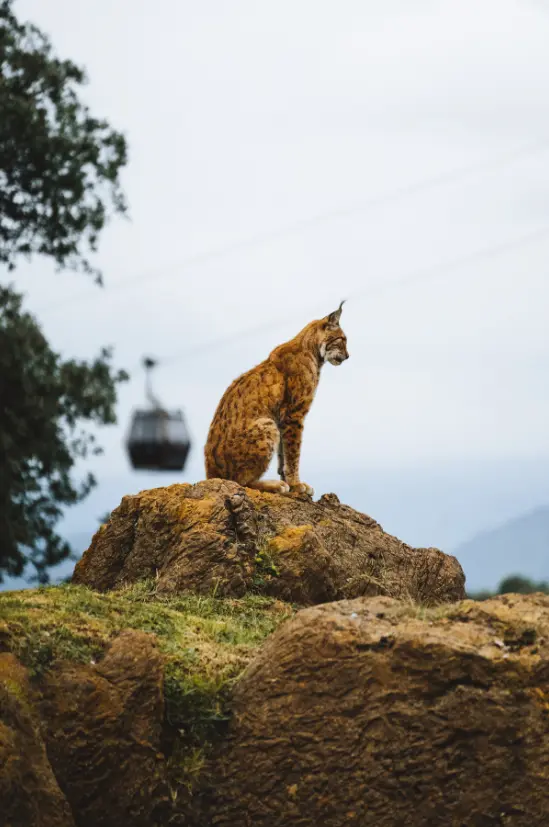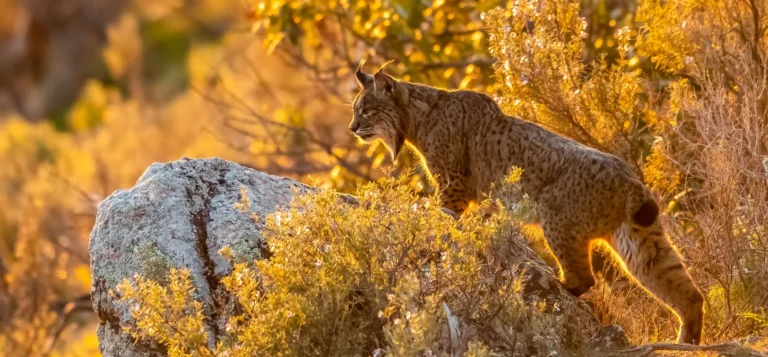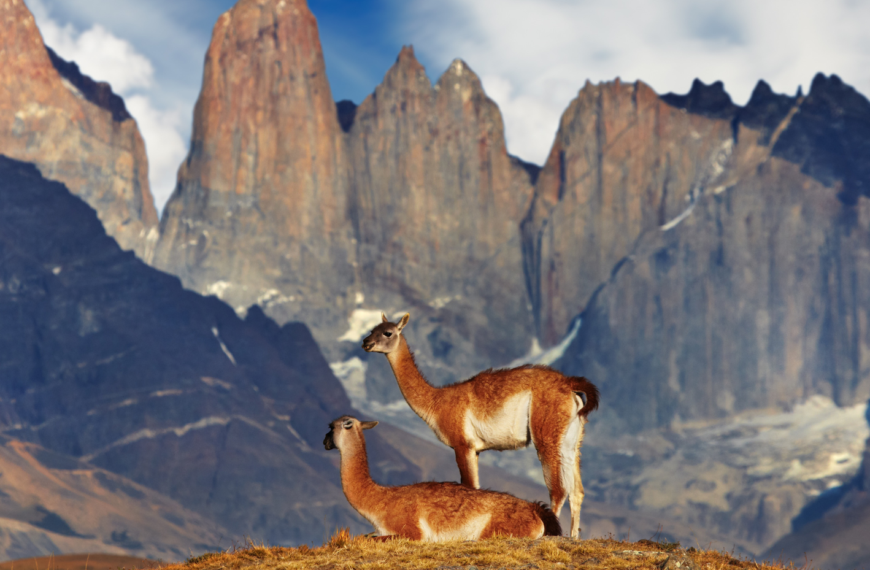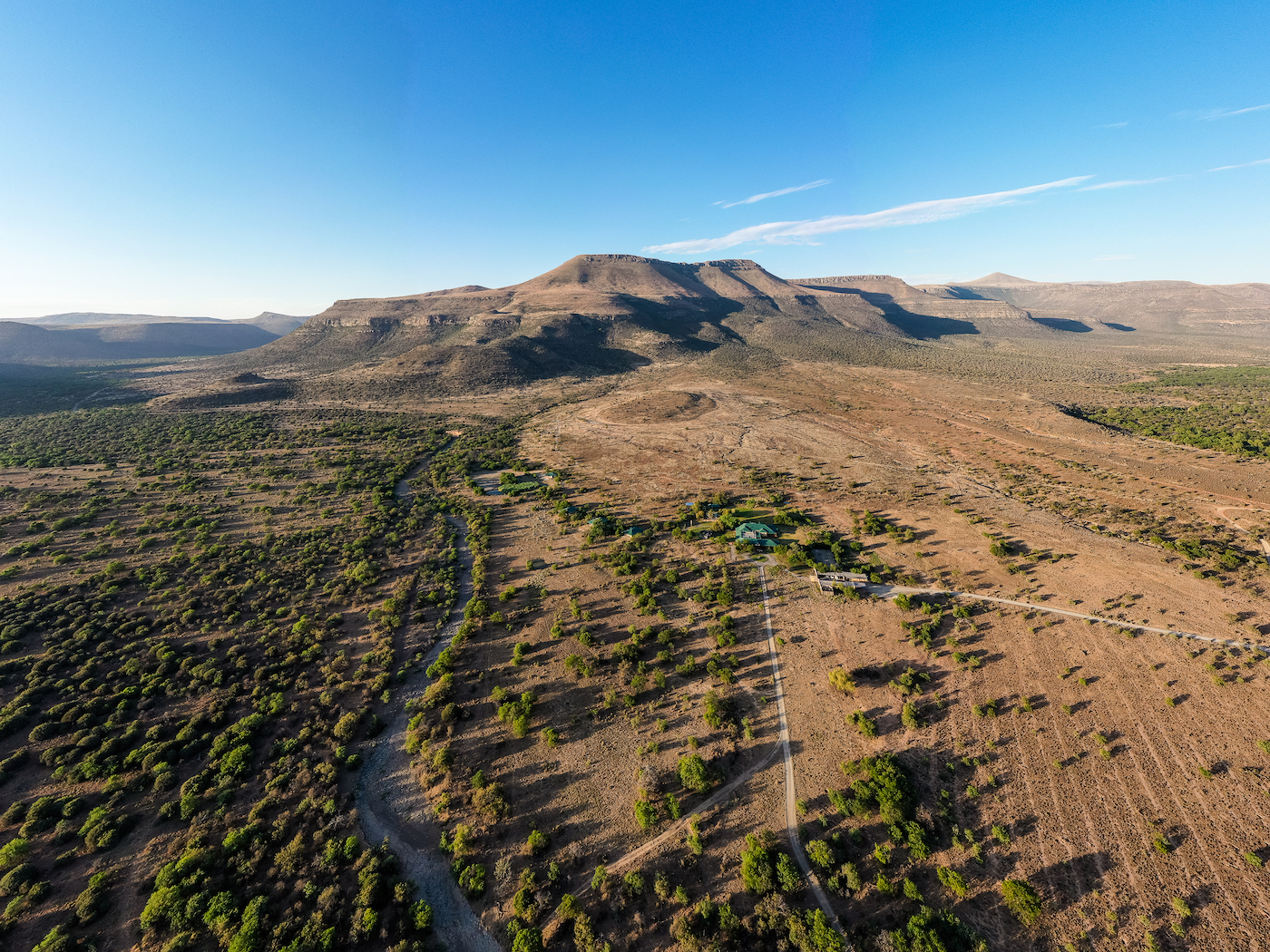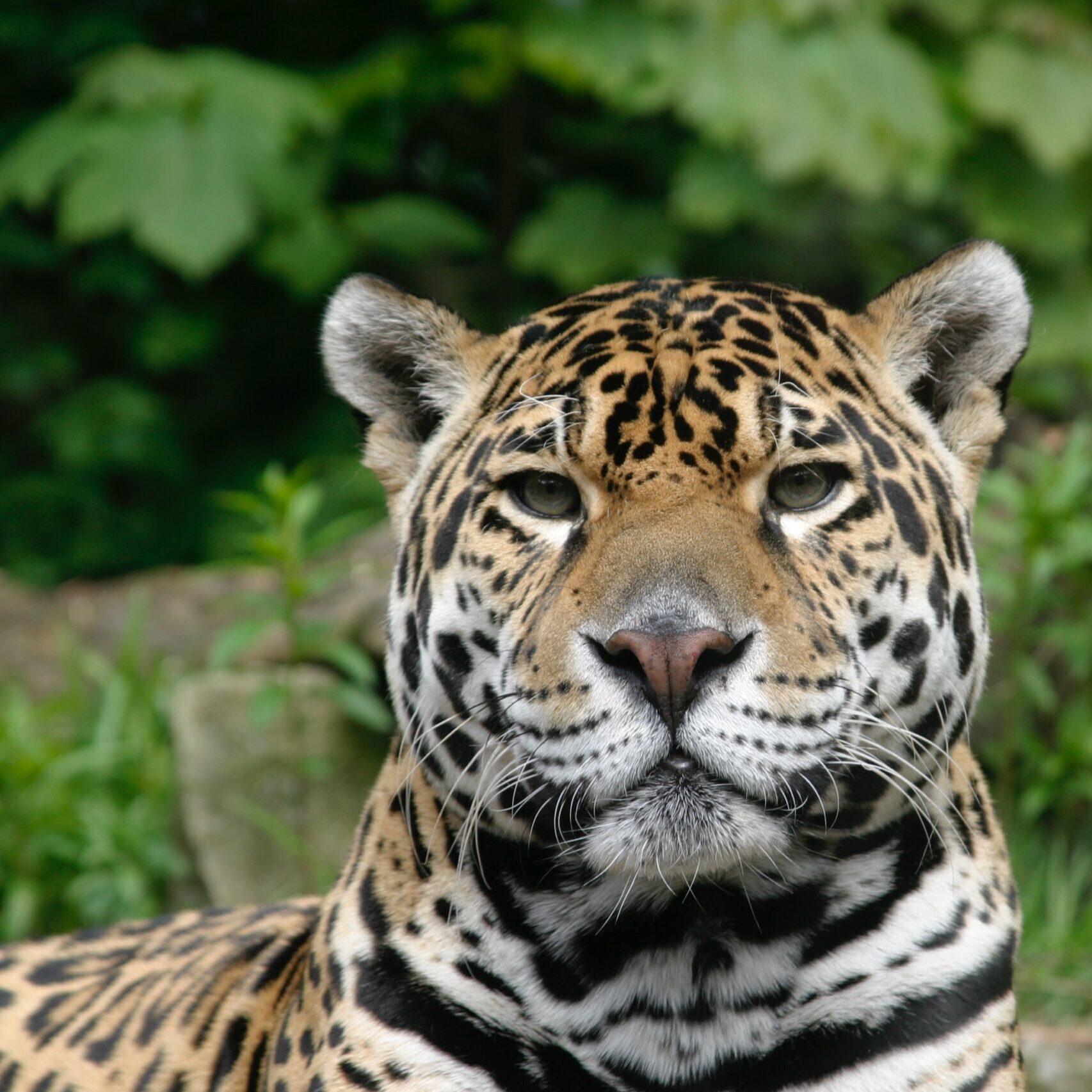From fewer than 100 individuals in the early 2000s to over 2,000 today, the Iberian lynx has made one of the most remarkable comebacks in conservation history. As a keystone species of the Mediterranean ecosystem, its story reveals the deep interconnectedness between landscapes, species and human impact.
In June 2024, the IUCN officially changed the lynx’s conservation status from ‘Endangered’ to ‘Vulnerable’. While this marks a significant milestone in biodiversity recovery, the Iberian lynx is still far from secure. Its future depends on a fragile chain of ecological conditions, especially the health of the European rabbit, its primary prey, which remains endangered in parts of the lynx’s range.
In this blog post, we explore the unique characteristics of the Iberian lynx habitat, examine why the species became endangered, and unpack the conservation and rewilding strategies giving this elusive feline a second chance. Once the world’s most endangered wild cat, the Iberian lynx now stands as a symbol of what’s possible when science, community and long-term vision come together. Its journey offers a rare window into how ecosystems collapse and how we can bring them back to life.
What Makes the Iberian Lynx Habitat Unique?
The Iberian lynx depends on one of Europe‘s most distinct and vulnerable landscapes: the Mediterranean scrubland. Found across southern Spain and Portugal, this ecosystem provides the cover, prey and breeding conditions the lynx needs to survive. It is a mosaic of dense thickets, open pastures, cork oak forests and dry grasslands.
This landscape is a lifeline for the lynx. It relies almost exclusively on European rabbits, which comprise around 90% of its diet, and on areas of undisturbed vegetation for stalking, shelter and raising young. But these conditions are becoming increasingly rare.
A Habitat Shaped by Ecology and Balance
A healthy Iberian lynx habitat includes:
- Open pastures – where rabbits graze and lynxes hunt
- Dense vegetation – essential for stalking prey and rearing young in safety
- Quiet, undisturbed areas – for breeding dens, often near natural water sources
- Corridors of connectivity – that allow isolated populations to mix and maintain genetic diversity
The presence of lynxes signals that an ecosystem is functioning well. As an apex predator, it regulates prey populations, indirectly supporting plant life and smaller species. Where lynxes return, other species often follow.
The Challenge of Fragmentation
Today, this habitat is under increasing pressure. Urban sprawl, agricultural expansion, infrastructure and monoculture plantations have made the Mediterranean ecosystem one of Europe’s most threatened. Roads, in particular, divide territories and pose a direct threat. Vehicle collisions are now one of the leading causes of lynx mortality.
For conservationists, addressing habitat loss and fragmentation is critical to ensuring the lynx’s long-term survival. Across the Iberian Peninsula, efforts are underway to reconnect broken landscapes, restore degraded scrubland and rebuild a viable network of habitat corridors that give this species the space it needs to thrive once more.
Why Is the Iberian Lynx Endangered?
The Iberian lynx was once critically endangered and faced near-certain extinction. Its population plummeted throughout the 20th century, reaching a low point in the early 2000s when just two isolated subpopulations remained in southern Spain. Although the species has remarkably recovered, it is still one of Europe’s most fragile carnivores.
Habitat Loss and Fragmentation
The Iberian lynx once roamed across much of the Iberian Peninsula. Over time, however, vast areas of its habitat were cleared or degraded due to urban development, road construction and agricultural expansion. In many cases, Mediterranean forests and scrubland were replaced by monoculture plantations or fragmented by infrastructure, cutting lynx populations off from one another.
Fragmentation also made lynxes more vulnerable to human-related threats such as road accidents, which remain a leading cause of non-natural deaths today.
Decline in Prey Populations
The Iberian lynx almost entirely depends on the European rabbit. However, the rabbit population has been devastated by repeated outbreaks of disease, particularly myxomatosis and rabbit haemorrhagic disease. In some regions, rabbit numbers declined by up to 90 per cent. Without this key food source, lynx populations collapsed alongside them.
Human Conflict and Persecution
Although now protected by law, lynxes were once hunted for their fur or targeted by farmers and gamekeepers who saw them as a threat. Accidental poisoning and illegal traps have also contributed to past declines and remain concerns in some reintroduction areas.
Genetic Bottlenecks and Isolation
By 2002, the total population of Iberian lynxes had fallen to fewer than 100 individuals, split between two isolated groups in Doñana and Sierra Morena. This extreme isolation led to inbreeding and a dangerous lack of genetic diversity, making the species more vulnerable to disease, reproductive challenges and environmental change.
Ongoing Threats
Despite the 2024 reclassification of the Iberian lynx from endangered to vulnerable, many of the conditions that caused its decline persist. Habitat continues to be lost or fragmented. Rabbit populations remain unstable. Reintroduced lynxes face risks from vehicle collisions and human conflict in new territories. Climate change adds further uncertainty, altering vegetation patterns and threatening the delicate balance of the Mediterranean ecosystem.
Long-term recovery requires more than maintaining population numbers. It depends on restoring the ecological and social systems that underpin the lynx’s future.
Iberian Lynx Conservation: A Story of Global Hope
The Iberian lynx is one of the few species to have stepped back from the brink of extinction, but its recovery took decades of collaboration between conservation scientists, governments, local communities and international organisations across Spain and Portugal.
Captive Breeding and Reintroduction
A turning point came with the creation of captive breeding centres, where genetically diverse individuals were carefully paired and prepared for life in the wild. Facilities like El Acebuche in Doñana National Park became the heart of this effort, ensuring that reintroduced lynxes were healthy and genetically resilient.
Since 2010, hundreds of lynxes have been released into restored habitats across southern Spain and Portugal. These areas are selected based on rabbit abundance, habitat quality and human cooperation. Each reintroduction is monitored through GPS tracking to understand how lynxes adapt and move through the landscape.
Habitat Restoration
Conservationists have focused on restoring the Mediterranean scrublands, cork oak forests and grasslands on which the lynx depends. This includes managing land use, reducing pesticide exposure and supporting prey availability in key areas through disease monitoring and habitat improvements.
Working with Local Communities
No recovery story is possible without the people who share the landscape. Conservationists have worked closely with landowners, hunters and farmers to build support for lynx protection. Compensation schemes and education programmes have helped reduce human-wildlife conflict and increase tolerance of the lynx’s return.
Many reintroduction areas are now places where residents take pride in the lynx’s presence. The species has even become a symbol of regional identity in parts of Andalusia and Alentejo.
The Role of International Projects
EU-funded initiatives such as LIFE Iberlince and LIFE LynxConnect have played a critical role in the lynx’s recovery. These programmes provide funding, coordination and long-term planning across national borders, focusing on everything from corridor design to scientific monitoring and public engagement.
Thanks to these collaborative efforts, the Iberian lynx was reclassified as vulnerable in 2024. As Francisco Javier Salcedo Ortiz, LIFE Lynx-Connect Project Coordinator, said: ‘The greatest recovery of a cat species ever achieved through conservation […] is the result of committed collaboration between public bodies, scientific institutions, NGOs, private companies, and community members including local landowners, farmers, gamekeepers, and hunters, and the financial and logistical support of the European Union LIFE project.’
It remains a species in recovery, but its trajectory offers a rare example of how conservation can work given time, resources and community commitment.
Iberian Lynx Rewilding: Expanding the Species’ Range
Rewilding has become one of the most ambitious and forward-looking strategies in the Iberian lynx’s recovery. Beyond stabilising existing populations, conservationists are now working to return the species to regions where it once roamed but had long vanished.
Bringing Lynxes Back to Lost Landscapes
Since 2010, reintroduction efforts have extended into areas like Extremadura, Castilla-La Mancha and Alentejo in Portugal. Each site is carefully chosen based on habitat quality, prey abundance and the willingness of local communities to support conservation goals.
These releases aim to create a connected, genetically diverse metapopulation that can thrive independently over time. Monitoring continues after release, using GPS collars and field research to assess adaptation, breeding and movement.
Preparing the Ground for Success
Successful rewilding begins long before any lynx is released. Conservationists work to restore scrubland, support rabbit populations and reduce human-related threats such as roads or poisoning. Corridors are being developed in some areas to help link isolated territories and enable safe dispersal.
Community engagement is also key. Many reintroduction projects include education programmes and economic incentives, encouraging locals to see the lynx as an asset rather than a threat.
A Vision for the Future
Rewilding the Iberian lynx is helping restore balance to ecosystems across the Iberian Peninsula. With continued support, this once near-extinct feline could become a defining success story of 21st-century conservation and a worldwide model for species recovery efforts.
What the Iberian Lynx Teaches Us
The Iberian lynx’s recovery is a conservation milestone, but it’s also a case study in resilience, restoration and collective effort. This species has faced the full weight of human-driven decline, from habitat loss to genetic isolation. Yet through decades of work by scientists, governments, landowners and local communities, the lynx has begun to reclaim its place in the wild.
But its story is not finished. Continued progress depends on the long-term protection of its habitat, the health of its prey, and the support of those who share its landscape. The Iberian lynx reminds us that recovery is possible, not just for species, but for ecosystems. And in the face of global biodiversity loss, that message is worth holding onto.
For travellers and conservationists alike, the lynx’s journey invites deeper questions about how we relate to the wild and how we can contribute to its renewal.
Interested in learning more about Iberian lynx rewilding?
Journeys with Purpose offers transformational travel experiences to connect with the people and projects leading this extraordinary recovery. If you’re curious to explore the Mediterranean’s wild heart in the field, we can help you travel with meaning, guided by the experts shaping its future. Get in touch to start your journey.
DIG A LITTLE DEEPER
Contribute to Positive Impact on a Hosted Journey.
Connect with Impact Partners around the world during a Private Experience.
View our 2024 Hosted Journey to The Great Karoo.
